The quick take
Samsung has in many ways doubled down on a feature-packed strategy with its wearables, making the Gear S3 the largest and most powerful smartwatch available today. It has a bigger screen, standalone software and many more features than you can get from the competition, including the same full GPS support, heart rate and activity tracking you find in its fitness-focused Gear Fit 2. The problem is that means the Gear S3 is too big for many wrists, adding to the fact that it has a bulky and male-focused design that's going to put off many potential buyers.
The good
- Nice design and materials
- Always-on watch faces are great
- Rotating bezel still wonderful
- Standard watch strap design
- Enables Samsung Pay for all
The bad
- Too big for many wrists
- Pile of features is daunting
- Clunky interaction with some apps
- LTE hurts battery, adds little value
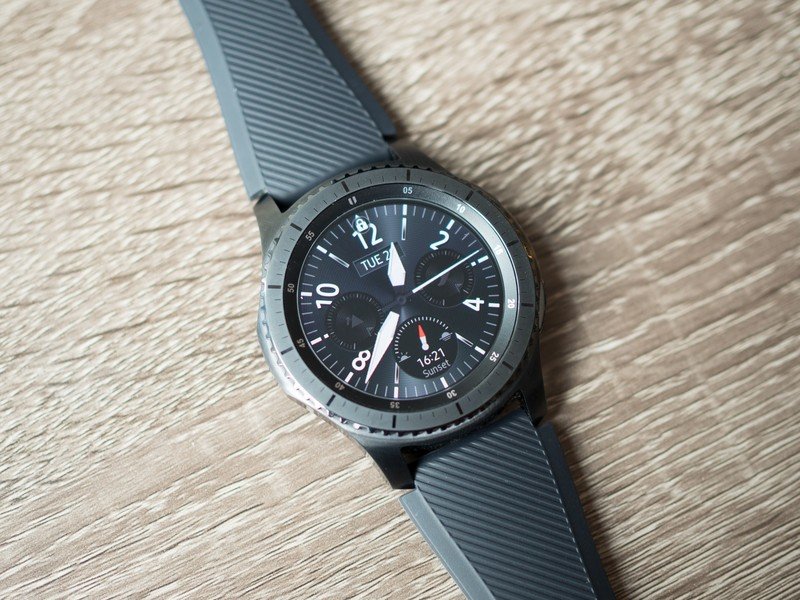
More is more
Gear S3 Full review
Samsung's Gear S2 of 2015 was a viable alternative to a pile of second-generation Android Wear offerings from a variety of companies, and offered a refreshing smartwatch experience that was thankfully accessible to those without Samsung phones. Its rotating bezel was truly innovative and gave you access to tons of software features you couldn't find elsewhere. It also offered a more compact and lighter form factor, while also giving longer battery life, for those who were put off by the extremely large Android Wear watches.
So it was confusing to many of us when Samsung announced the Gear S3, coming in both a Classic and Frontier design, that was dramatically larger than the Gear S2. Going bigger enabled Samsung to take everything the Gear S2 did and add even more. It still has its rotating bezel, standard watch band connection, tons of software features and optional cellular connectivity, but now it packs GPS, a bigger battery, full Samsung Pay support and new software features to make it even more useful even when your phone isn't around.
But in doing so, Samsung is walking the line of alienating a large portion of the population who just want a smaller, simpler smartwatch that gets the basics done, looks nice and fits on those with average-sized wrists. There's no doubt that Samsung is doing the most out of any company with a single wrist-bound wearable, but is it trying to do too much? We find out in our complete Samsung Gear S3 review.
Get the latest news from Android Central, your trusted companion in the world of Android
About this review
I (Andrew Martonik) am writing this review after one week using the Gear S3 Frontier LTE, with service provided by AT&T. The watch was used primarily connected to a Google Pixel during the review period. After an initial software update the day of receiving the watch, nothing else in the software changed. The Gear S3 was provided to Android Central for review by Samsung.

Go big or go home
Gear S3 Hardware
The Gear S2's offering of your choice of either a sleek sports-style design or classic timepiece look was a somewhat-differentiating factor for the watch, but that's all gone now with the Gear S3. I'm reviewing the Gear S3 "Frontier" model, but it isn't far removed from the "Classic" model — they both have the same dimensions, specs, screen and capabilities (aside from the Frontier's optional LTE), but different external case designs. For this reason, I'll interchangeably refer to both as "Gear S3" unless there's something specific to point out about one model.
To quickly point out the differences, you can see my initial hands-on with the watches; the Classic comes with a shinier chrome-like finish, a more understated bezel and classic watch-style buttons, while the Frontier is black and monolithic, with a bulkier gnarled bezel and large rubber-textured buttons. Both are interoperable with standard 22 mm bands, but ship with different styles: the Classic with a basic leather band, and the Frontier with a heftier rubber band.
Something that doesn't come across immediately in product renders online is the overall bulk of the Gear S3. With a 46 mm case (49 mm at the lugs) and perhaps more importantly 12.9 mm thickness, it's both wide and thick in a way that instantly reminds you this is a wrist-mounted computer and not a slick mechanical timepiece. I'm a six-foot four-inch tall guy with large wrists that feel comfortable with watches up to about 50 mm, so I obviously don't have an issue with the Gear S3's size, but I just don't see how this watch will fit comfortably on most people — particularly women. The Gear S3 Frontier's design is particularly masculine and tough, so I get that it's larger; but then you realize that the Gear S3 Classic is the same size even though it has a more gender-neutral look. No matter how much you like the looks, I encourage everyone to go try it on in a store before buying — you may find it to be unmanageably large.

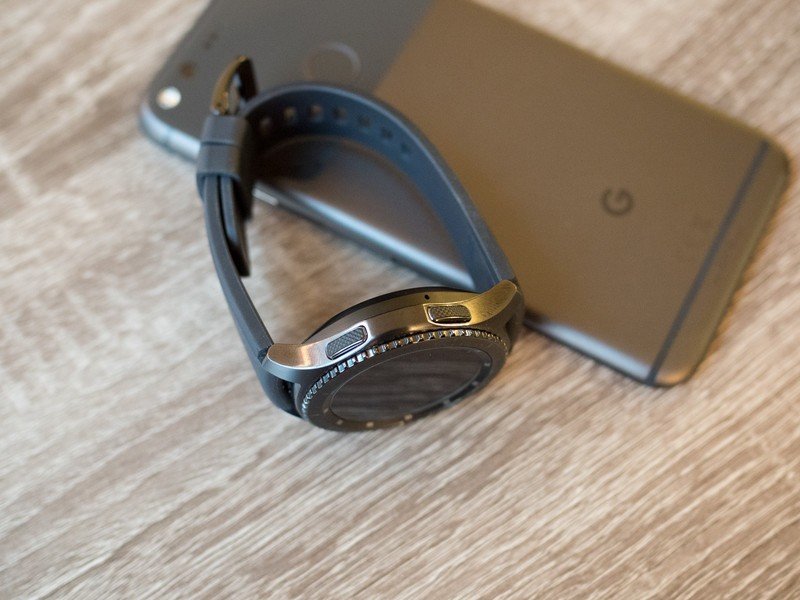

Size aside, the Gear S3 is built to fit in with the top-end smartwatches out there. The Gear S3 is particularly well sculpted out of 316L stainless steel and the two-tone brushed/shiny finish really stands out. The trademark rotating bezel requires just enough effort to spin, making it easy to move a single click for fine selections or several clicks to scroll through a long menu. Both Gear S3 models are IP68 dust- and water-resistant, meaning it can handle all reasonable amounts of contact with water; the Frontier is also MIL-STD 810G rated, meaning it can handle extra levels of shock, heat/cold, pressure and vibration.
It's beautiful and well-made, but positively massive.
The included rubber band fits the Frontier's look well and is capable of fitting in whether you're dressing up or keeping casual. The Classic's leather band is nice as well (recalling from my admittedly short time with it in August), but you can do far better buying something for $25 on Amazon.
Sadly the bottom one-third or so of the watch is a jarring bit of hard plastic that stands out from the fine metal above it and detracts from the feel of the watch on your wrist. The plastic is necessary from the standpoint of having radios in the watch, but that doesn't mean it's particularly gracefully integrated into the design. I really wish there was a more elegant solution implemented here that shrouded your wrist from coming in contact with the plastic and kept it from being seen when viewing the watch from the side. The plastic is somewhat hidden on the Gear S3 Frontier because it's all black, but is particularly easy to see on the Classic, as the black plastic backing stands out strongly from the silver metal.
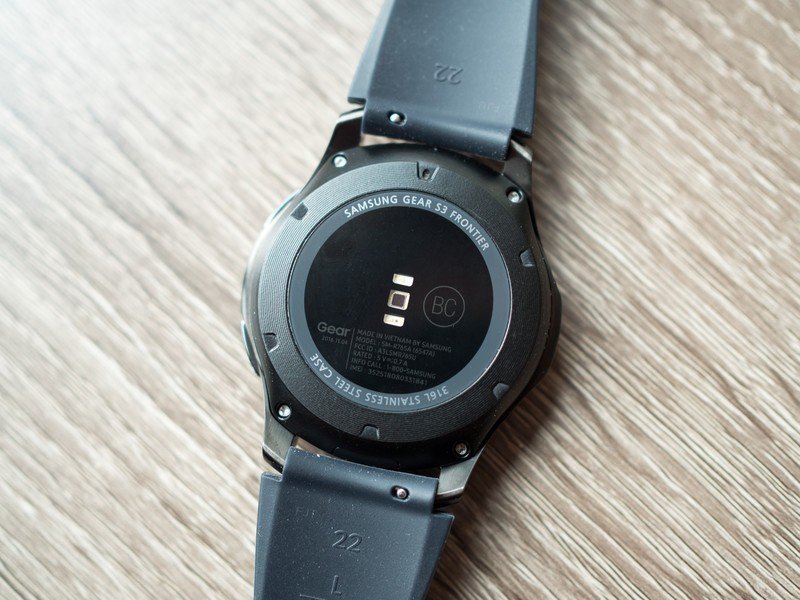

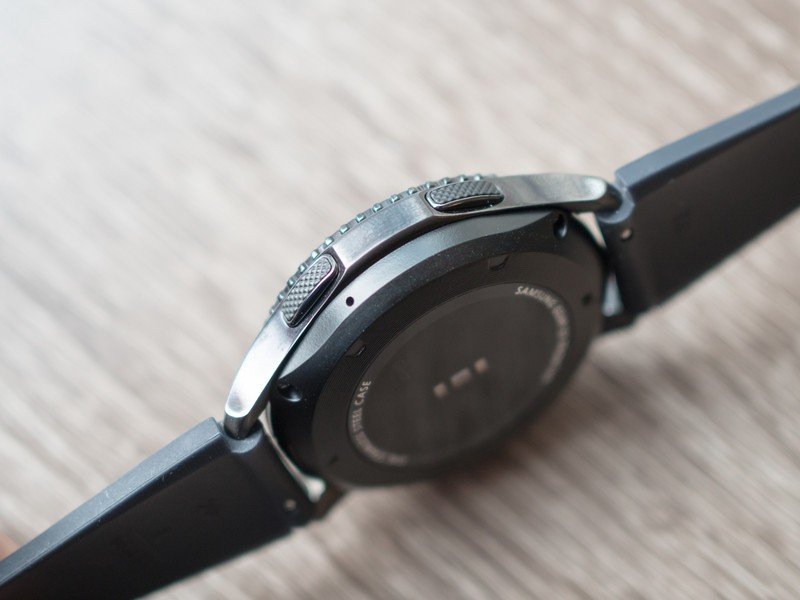
Samsung of course nailed the display on the Gear S3, bumping up in size to a 1.3-inch circular OLED panel — covered by Gorilla Glass SR+ — with great colors, good brightness and amazing viewing angles — the latter of which being incredibly important for a smartwatch. And because the watch is primarily set up for interaction via the rotating bezel, you spend less time covering and smudging up the display as you use it throughout the day. That's not something you think about at first, but really enjoy when you don't have to wipe down the display on your watch every hour.
This is the best implementation of always-on watch faces yet.
What really makes you appreciate the display is new always-on display modes for the Gear S3's watch faces. There are 16 watch faces included and dozens more available for download, but I settled on a few of the analog-style faces that matched nicely with the Frontier's external hardware. Adapting the same idea introduced on the Galaxy S7, the Gear S3's watch faces dim but keep running when you're done using the watch.
But this isn't simply just turning down the brightness of the display — the watch faces actually shift to a simple, slightly lower resolution version of the face that drains less battery while offering full visibility of time, including a moving second hand. As soon as you raise your wrist the complete watch face comes to life without skipping a beat. This makes the Gear S3 feel more like a "real" watch than the competition, and I love the implementation. While in use the display doesn't offer an automatic brightness setting, per se, but does offer an "auto-low" setting that dims the screen in dark situations — kind of the reverse of what we're used to, but still useful nonetheless.

A whole lot going on
Gear S3 Software and experience
Samsung already offered considerably more features in its Gear S2 software than what we had on Android Wear, and that basic feature set hasn't changed much a year on — scrolling through the interface and getting into the settings, you won't notice any major visual differences. In fact, all of the non-hardware-dependent software changes will soon be running on the Gear S2 thanks to a software update.
Samsung continues to push to the idea of the watch as a purely standalone device, starting with the Gear S3 Frontier's optional LTE connection (more on that below) but also by allowing you to install and operate apps directly on the watch without communication to a phone at all. Aside from the fact that the Gear S3 can pull in notifications from your phone and let you act on many of them, everything else can work directly on the watch. There's a standalone experience for your calendar, contacts, weather, alarms, to-do list, music player, news reader and more, plus you can install apps like Uber and ESPN that work independently on the watch.
I wasn't interested in poking around on a tiny display to read snippets of news.
It's still all a bit much to manage, even with the larger screen and superb rotating bezel that make navigation as easy as possible on a smartwatch. I quickly settled into a daily routine that had me spending 99% of my time on the watch face, in notifications and in the weather app. I wasn't interested in poking around on a tiny display to read snippets of news or painfully scroll through dozens of calendar appointments. The only time I ever went into the app launcher was to go to the settings.
The best thing about the Gear S3 is that you don't have to use any of the superfluous features — you can pick and choose the few experiences that add to your life, and trash the rest. Just configure the widgets that you want, stay away from the cluttered app drawer and skip installing unnecessary (and generally poorly made) watch apps, and you'll be good.
Samsung Pay
The Gear S3 offers full Samsung Pay support, including Samsung's exclusive MST technology that lets you pay at traditional swiping card readers. Just as importantly, Samsung has expanded Pay to work with non-Samsung phones as well — all you have to do is install the proper add-on to the Gear app on your Android 4.4+ phone, and you'll be able to add your credit and debit cards. Now they won't be able to be used anywhere but the watch, but that's fine; it still gives people a little taste of what Samsung Pay is like, and is great to see included. Samsung could have easily kept this exclusive to its own phones.
Samsung Pay takes a few minutes to get set up, but once you have it configured things are simple. Long-press the "back" button on your watch, rotate the bezel to choose between your cards, then tap "Pay" and hold the watch near the payment terminal. The watch doesn't have to be connected to a network or Bluetooth to make a payment, but instead has a limited number of one-time payment tokens securely stored on the watch and must sync back up to your phone periodically to refresh them. The Gear S3 also requires that you have a PIN lock in order to use Samsung Pay — as soon as the watch comes off your wrist, you'll have to enter the PIN again.
Fitness tracking

After using Samsung's Gear Fit 2 as my daily activity tracker for the past couple of months I was already very in tune with the S Health fitness and activity tracking available on the Gear S3, which is identical aside from its slightly different display of information on the larger, circular screen. The Gear S3 can follow your daily steps, take regular heart rate readings, count the number of floors climbed throughout the day and track distance-based activities like running via GPS — it all gets rounded up into a nice 24-hour log of your activity each day.
In all respects it's a full-blown fitness tracker ... except for the fact that it's a big watch. It's huge by fitness band standards, but admittedly about on par in size to fitness-focused running watches (though often have more features preferred by intense runners). The size may not bother you for runs, but won't be acceptable for gym workouts, yoga or team sports in the same way that a small and simple fitness band is. It's also far too big to wear while sleeping, completely negating the sleep tracking functions I quite enjoy on the Gear Fit 2.
Even if you don't use it for sleep tracking or a majority of your workouts, you're going to have to realize that you'll never get a full representation of your activity from a watch that you don't wear anywhere near 24 hours per day and gets less than two full days of battery life. You're going to miss workouts, you'll miss many steps and floors climbed, and you won't be tracking sleep. Get a Gear Fit 2 if you want a fitness-focused wearable — it's a great device.
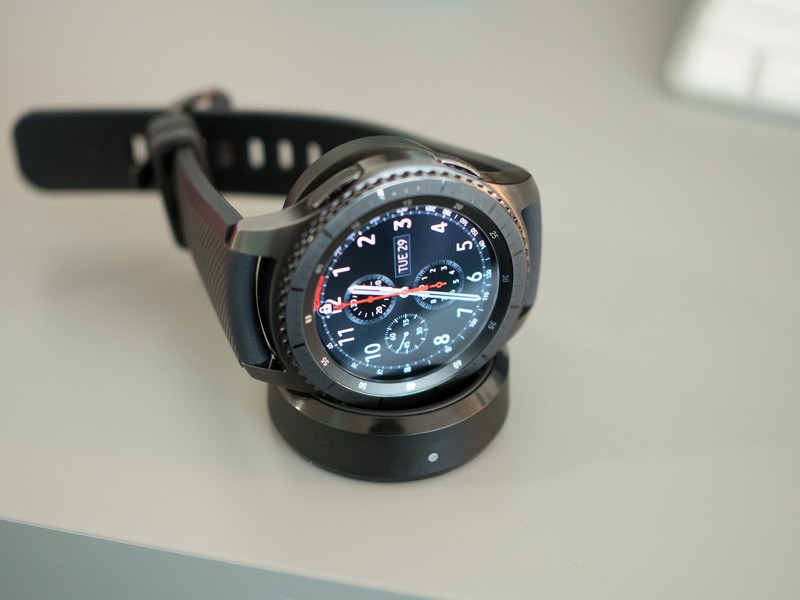
Battery life
By using its own operating system and processor, Samsung is able to get solid battery life out of a battery cell that's a bit smaller than the competition. The Gear S3's 13 mm thick case houses a larger 380 mAh battery, which Samsung claims is good for 3 days of "average" use. But with a watch that has so many features, apps, settings and configuration options I'm not sure what it considers to be "average." I found the Gear S3 to consistently use 40-50% of its battery over the course of a full day, meaning two full days wasn't out of the question but it certainly couldn't make it to a third day, let alone complete it.
If you're using always-on watch faces, expect two days of battery at most.
A huge factor in battery life here is the use of the always-on display mode and how you have your networks set. As noted above the always-on watch faces look great and even function with a moving second hand, giving the appearance of a real watch at a glance without having to lift your wrist a certain way to activate it. Always-on display is not turned on by default, and keeping that OLED display lit up (even though it is dim and simplified) puts a drain on the battery. But I think the always-on display is a major feature of the Gear S3, and I wouldn't choose to use it without the feature turned on — for me, it's worth losing almost a day of battery life over. It's that good.
Samsung actually quotes a day less of battery life for the Frontier LTE model, but again that depends how you use it. By default the watch has its mobile network set to "auto" in order to only connect to LTE when Bluetooth is unavailable — so even if you don't use it, just having the radio available and ready to connect takes battery. Indeed when I turned off LTE entirely — replacing it with Wi-Fi set to "auto" instead — my battery life improved by roughly 5 percentage points over the course of the day. Still not enough to reach three days of battery life, but worth considering for those times when you don't expect to need LTE for a while.
LTE connectivity
Just like the Gear S2, you can get a Gear S3 Frontier with its own mobile network connection. This year it's LTE, and at the time of writing you can get service for a monthly fee from both T-Mobile{.nofollow} and AT&T, with others expected in the future. Pricing differs both up-front and monthly, but you're looking at roughly $249-$399 for the watch itself, plus about $10 per month for the service. That includes features like automatic number syncing for seamless calling on your watch without your phone, and of course the data required to use apps and streaming services on the watch itself.
I see nothing here that justifies paying an extra $10 per month for a watch data plan.
Beyond being able to make calls and send text messages from your phone, the Gear S3 acts identically on LTE as the non-mobile versions act when connected to Wi-Fi. If you enable the proper settings the watch will keep itself in sync with your phone if both are connected to a network, feeding you notifications and keeping apps on the watch current. The notifications are a bit limited, though, as you don't have the ability to archive email or reply to messages — an expected limitation considering the situation.
Do you need a watch with its own LTE connection? I'll be honest, you probably don't. Not for $10 per month, anyway. Wi-Fi is included on all Gear S3s and will handle situations in which your phone is across the house, and pre-loading media to listen to will probably be a fine substitute for Spotify streaming on the watch as well.
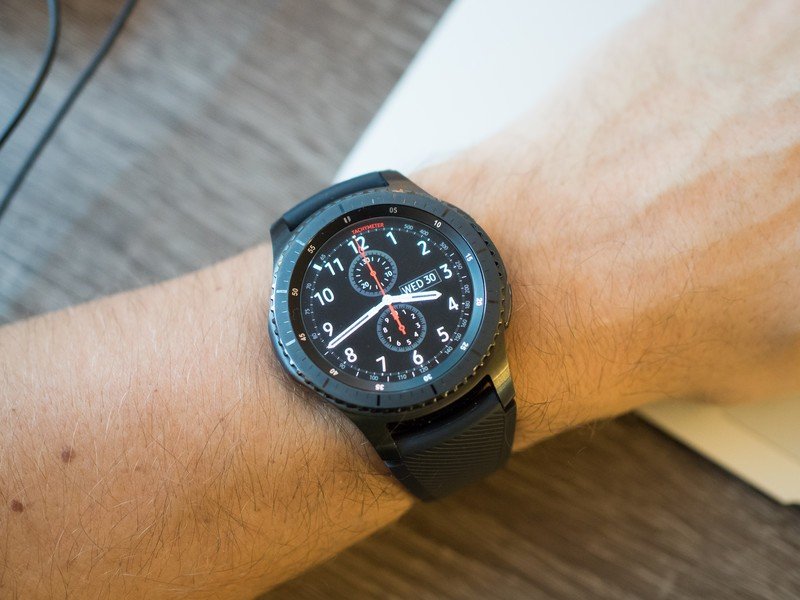
Doubling down on the hardcore
Gear S3 Bottom line
With the Gear S3 Frontier and Classic, Samsung has chosen to keep with its "more is more" strategy of simply adding as many software features and hardware capabilities as possible to its wearables. The result is once again a smartwatch that will do just about anything you ask it to, including function as a full replacement for your phone for short periods. It has its own app catalogue, can use an LTE connection to stream music and will even let you make calls on it. You can type text messages on a keyboard, watch YouTube videos and call an Uber without a phone anywhere near you.
The problem, once again, is that nobody will use anywhere near all of these features.
The problem though, once again, is that nobody will use anywhere near all of these features. When you add up all of the things the Gear S3 does it's easy to say "wow that does a ton of stuff, it's worth the money!" — but you have to take a step back and consider how many things you'll actually use on a daily or even weekly basis. You'll pick and choose a few key features for you, and then disable or ignore the rest.
The Gear S3's hardware and design is great, so long as you can deal with the size of it. Its display and always-on watch faces are top notch. Notifications fully sync with your phone, keeping the bigger device in your pocket more often. S Health fitness tracking is good for casual observation of your activity throughout the hours you have a watch on. Samsung Pay is a fantastic technology, and is truly useful for quick purchases on the go.
Does it all add up to a smartwatch experience that's worth $349, and potentially $10 more per month on top of that for LTE? Well right off the top, I'd say skip the LTE if you're considering a Gear S3 — there just isn't enough there to justify the price. But when it comes to buying the standalone watch, that's a tougher decision. If you've already made the decision that $300+ is an acceptable price for a smartwatch, the Gear S3 is worth looking at for all of its redeeming qualities. For others who may not have spent much more than $349 on their phone itself, it's a tougher sell — the Gear S3 is nice, but when you consider what you'll actually use it for, it'll be hard to spend the money. You may just land on buying last year's Gear S2 or a fitness-focused Gear Fit 2 for far less money and end up being much happier.

Andrew was an Executive Editor, U.S. at Android Central between 2012 and 2020.


